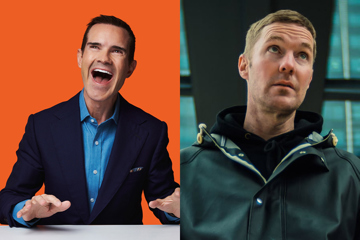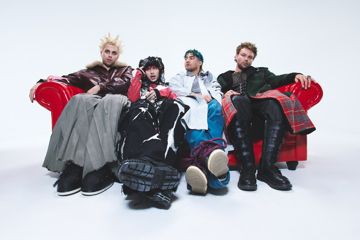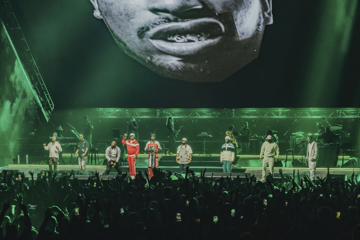The Glorious Mess That Is Inherent Vice
Joaquin Phoenix leads a wild cast in Paul Thomas Anderson's 'glorious mess' of a film, while Chris Rock takes an evolutionary leap
INHERENT VICE

After the towering artistic triumphs of There Will Be Blood and The Master, Paul Thomas Anderson had to come down somehow. Of course, ‘come down’ isn’t the most apt phrase to describe the dismount, here, from staggering heights to shaggy-dog private-dick movie, given the tenor of Inherent Vice is set by its characters' constant intake of coke, heroin, pills, peyote, acid, nitrous oxide et al. Adapting Thomas Pynchon’s novel of the same name, it’s set in a psychedelic 1970 Los Angeles, in which the burgeoning hippie generation is already showing the dark underside beneath the sunshine and good vibes. Counter-culture is being swiftly co-opted by commercial interests, political parties, and the police; and all that endless drug use has brought on a collective state of sustained paranoia.
The flick delivers a massively mutton-chopped, stumbling-and-bumbling Joaquin Phoenix as a PI whose old flame, Katherine Waterston, blows in through the door, femme fatale-style, and lures him into a web of power, corruption, and lies. On the trail of clues and conspiracy, he meets a wild cast of characters, wildly cast. There’s choice roles for the Reese Witherspoon revival, Benicio Del Toro, Owen Wilson, and Josh Brolin; and eye-opening old-dog turns from Martin Short, Eric Roberts, Martin Donovan, and Peter McRobbie as disreputable men. And, in the margins, there’s everyone from former pornstar Belladonna, to 22 Jump Street scene-stealer Jillian Bell, Treme’s Hong Chau, and, oh yes, the 21st century’s greatest musician, Joanna Newsom, who plays Phoenix’s astrologically driven, unflappably wise off-sider, and narrates the movie whilst she’s at it.
Don't miss a beat with our FREE daily newsletter
With its cast full of colourful characters and mouthfuls of words, Inherent Vice is bright, silly, showy; Anderson’s roving camera recalling his Boogie Nights beginnings, not his recent formalism. He takes its cue from the text, which is full of energy, Pynchon’s prose ricocheting from line to line.
The story is, in so many ways, about storytelling: about the novelist’s ability to dream up ridiculous characters; the way lives are turned into narratives; the way an old-fashioned detective was really on the trail of tales, often tall, some true; with information so much a currency that informers are routinely paid off.
If there’s a centre to the film it’s, suitably enough, off-centre, where Del Toro hangs at the fringes, as a maritime lawyer with an ear to the ground and a hot tip on his lips. Stories bleed into stories, and the pullback reveal when the grand conspiracy finally does come to light does little to make sense of the convoluted, ridiculous premise. Inherent Vice is, in many ways, a glorious mess; making it antithetical to the two films that preceded it, but no less singular an Anderson vision.
TOP FIVE

Top Five begins with Chris Rock and Rosario Dawson walking down a Manhattan street, mid-conversation. The words are zinging back-and-forth, the actors are nestled in that sweet spot between being themselves and acting their asses off, and Rock, as ever, is funny. Rock’s third directorial feature careens in lots of directions, both comic and dramatic, across its brisk, bawdy 100 minutes, but the scenes in which Rock and Dawson walk and talk remain at the movie’s heart, and function as its heartbeat.
After a forgettable sitcom-esque debut (2003’s black-president barney Head Of State) and an attempt at a more mature, artful follow-up (2007’s I Think I Love My Wife, which took a kernel of inspiration from Éric Rohmer), Top Five marks an evolutionary leap for Rock, as both filmmaker and performer. He plays, essentially, a version of himself: a successful stand-up-turned-comedy superstar attempting to make it as a serious actor. It’s a ‘personal’ role that serves both dramatic and comic purposes: Rock getting to be self-aware, and vulnerable, whilst making jokes that mock the misfires of his own career, and the celebrity milieu in which he dwells.
The fairly bare-bones plot goes like this: on the day his Haitian-slave-rebellion drama opens in New York, Rock handles press, whilst Dawson, a writer out to pen a feature on him, tags along. No one is particularly interested in the comedian’s attempt at artistic credibility, though; especially not when he has a wedding to a reality-TV starlet — played, with plenty of panache and little vanity, by Gabrielle Union — scheduled for that weekend.
As the day progresses, there’s a run of celebrity cameos — Adam Sandler, Jerry Seinfeld, Whoopi Goldberg, DMX, Taraji P. Henson, Gabourey Sidibe — playing wry versions of themselves. And there’s a wild cast of high-comic characters: Cedric The Entertainer getting his Gus Petch on as randy promoter; J.B Smoove a ladies-man manager; Kevin Hart a wise-talking agent; Tracy Morgan a loudmouth who ends up the butt of everyone’s jokes.
Amidst the colourful cast, Rock and Dawson — each playing alcoholics mid-sobriety; sating evangelical America’s need for bottoming-out/redemption stories — get to have a few moments of unvarnished human connection, and sparks, of course, eventually fly; Rock, in the face of such, forced to weight up what’s ‘real’. These walking-and-talking moments have drawn comparison to Richard Linklater’s Before movies, but that seems as much of a stretch as citing Rohmer. Instead, Rock’s work with Before star Julie Delpy, on 2 Days In New York, seems most influential, as both writer and director.
There’s a real sense of kinetic energy to Top Five, drawn from its story-in-motion, from the neuroses of its characters, and from the way New York presses in on every frame. There’s an undeniable joy at play in those that are performing: the chance to be making something funny that isn’t awful; to make a black comedy that isn’t a Tyler Perry movie; and, with Dawson, the chance to play a character that isn’t a cut-out love-interest. Rock, as a performer, has always had a surplus of such energy; with Top Five, he’s found a way to infuse a whole film with that.
THE HOMESMAN

Those who like their frontier parables dirty and grim are in for a treat with Tommy Lee Jones’s dour drama The Homesman, which is a Western only in its desert settings, horseback rides, terrifying Indians, and journey across the interior. Jones and Hillary Swank play a mismatched buddy-cop pair — he’s a drunken reprobate, she’s stern, serious, and determined — charged with transporting three gone-crazy frontier women (Miranda Otto, Grace Gummer, Sonja Richter) across the state border into Iowa.
Jones’s vision of frontier life is a barren hell, the landscapes suffocating in their vast emptiness, their unforgiving dryness, their frigid cold. Rodrigo Pieta — Alejandro González Iñárritu’s DOP, who, notably, also shot Brokeback Mountain — shoots these desolate landscapes with dry lines and horizontal horizons, a palpable air of danger creeping in at every edge of the frame.
Working from Glendon Swarthout’s novel, Jones is telling a story that has little Western revisionism, and few notes of pat redemption. It’s a drama as hard and unforgiving as the landscape: its dourness never quite lifting; its cruel developments and oblique, symbolic ending giving it an eerie, unsatisfying air that’ll please those who want questions from their cinema, not answers.
NATIONAL GALLERY

Frederick Wiseman’s ongoing obsession with observationist studies of institutions has been raging for a half-century, now; from his legendary Titicut Follies in 1967, through to his 45th film, a portrait of London’s National Gallery. National Gallery is long — three hours solid — with little narrative drive; instead, as is Wiseman’s way, he looks on and listens in to gallery staffers at work, presenting unalloyed snatches of real time. Sometimes, it can be incredibly dry. Once more, we sit in on literal budget meetings, Wiseman fascinated with how institutions are beholden to the bottom line, that art (and, more damningly, in his previous film, At Berkeley, education) is yet more grist for the capitalist mill.
Where National Gallery really sings — and will captivate the crowd that it will play to — is when we see the human love for the art that remains, beyond the budgeting, marketing, and politics, at the gallery’s centre. Guides speak eloquently about artworks; the place of light — in both gallery and painting — is discussed with both scientific exactitude and religious reverence; and restorationists detail the obsessive nature of their craft.
As the film, slowly, becomes a portrait of how artworks are preserved and maintained — how the effects of time are staved off — a poignant meta-text lingers. Wiseman is now 85, his career having begun in a now-long-distant era of celluloid and editing blocks, yet flourishing in the entirely digital now. With his life coming to an end, it’s only natural for Wiseman to think of art-preservation in the most personal way: wondering how his own artworks will live on after he's died, and how people will preserve the digital.
EDEN

Last week’s reviewin’ broke down the 2015 French Film Festival, but with the actual fest now on in cinemas, it’d be remiss not to cover FFF’s true highlight, Mia Hansen-Løve’s Eden, for which your old pal Film Carew was there opening day, front-row-centre. Based, loosely, on the experiences of her brother, Sven, Hansen-Løve’s fourth feature allies itself with the French house uprising of the 1990s; giving us Félix de Givry as a garage DJ at the centre of a scene of ravers.
But, like all of Hansen-Løve’s films (All Is Forgiven, The Father Of My Children, and Goodbye First Love), Eden is concerned with no single moment, but the passage of time; the way life bends and sways, but always forges forth, always changes. There are few moments of outright victory or defeat, no easy highs or melodramatic lows, no pat resolutions, no morals to teach, no real beginnings or ends. It begins, memorably, in the disorienting darkness, figures moving through the countryside either towards or away from the throbbing sound of a distant rave. We meet an ensemble cast before de Givry steps out from it, and the film follows him for over 20 years. There are dance parties, girls, drugs, and Daft Punk, but mostly there are just moments: memorable instances gathered together with the impression of memory.
The effect is not-too-dissimilar to Olivier Assayas’s Something In The Air, in which a film about May-’68ers pressed outwards, and onwards, rambling through the years (Assayas, Hansen-Løve’s real-life squeeze, seemingly inspired by her). De Givry was in that film, as were many of his co-stars, here; Hansen-Løve populating the central cast with lesser-known lights, and then bringing bigger names — Golshifteh Farahani, Vincent Macaigne, Laura Smet, Greta Gerwig, Brady Corbet, a host of real-life house musicians — around the margins.
Characters come and go, sometimes they come back, sometimes they don’t. No scene is static, self-contained. Some friends end up as multi-millionaire Grammy winners, some broke, some dead. Most everyone eventually has kids. Eden moves on as life does: fluidly, insistently, without ceremony. Those expecting a trad biopic or conservative narrative may feel as if Eden pulls the rug out from under their feet; but anyone who likes handing themselves over to a film will feel joy — true joy.







